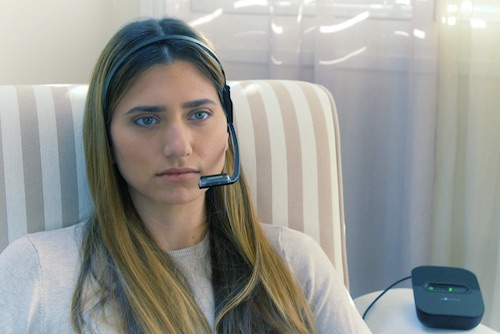The EyeControl – a ground-breaking communication device for individuals with Locked-In Syndrome – is now available on NHS Supply Chain Framework. It is the world’s first AI-powered, wearable eye tracking device, enabling 24/7 immediate communication, both for emergency and social purposes, a feat that previous solutions have not addressed.
Or Retzkin, CEO of EyeControl says “Since our launch in the UK in August we’ve received very positive feedback on our device. We’re thrilled to be officially working with the NHS to enable patients to once again communicate with their loved ones and carers in a simple, intuitive, and innovative way.”
The EyeControl device consists of a head-mounted infrared camera that tracks the eye movements of a wearer and translates it into audio communication via a speaker. A bone conduction element that sits within the earpiece provides audio feedback to the user, allowing them to hear the communication before it is sent to the output speaker. The wearer can use predefined sentences or teach the EyeControl their own personalised syntax, as well as choose from a range of output languages and the device features Bluetooth wireless technology and works without a screen. The learning curve is extraordinarily simple, with patients able to easily use the device within 20 minutes.
Helen Paterson, speech therapist at The Royal Hospital of Neuro-disability recently tested The EyeControl device with a number of her patients and said, “The brilliant thing about The EyeControl over alternative communication devices is that it’s quite light and easy to wear and patients can communicate but they don’t have to have a big screen in front of them and they only need to move their eyes up and down and side to side. This means they don’t have to rely on having their device in front of them all the time, which obviously makes communication much easier for locked-in patients.
“For me as a speech and language therapist, working with people face-to-face, it’s really important that we have a system that’s easy to set up, that’s flexible and can be edited and adapted for each patient by the user, but also therapists. The EyeControl is a great, easy to set up system and it can be set up easily and simply. It’s also very easy to demonstrate how the device works to other carers.”
Debbie Burrells was diagnosed with an aggressive form of motor neurone disease six months ago and has already been plagued with muscle weakness, acute exhaustion and her voice is deteriorating. EyeControl recently visited Debbie who says, “My voice is my lifeline, being such an extrovert and always chatting with my family and friends. However, I was fortunate enough to be involved with EyeControl. I recently gave the device a go and it is amazing! The best part about it is that you still have your freedom of what you want to say I feel very strongly that we should be able to have one of these before our voices completely go. It’s bad enough to lose communication but it will be much easier if we could just go over to this new device.”
Retzkin concludes, “We’re on a mission to provide a voice to as many locked-in individuals such as Debbie as possible and working in conjunction with NHS Supply Chain will allow us to do so. We’re excited to deliver the first devices to patients at the end of this year and look forward to seeing our device transform the lives of locked-in patients in the UK, as well as their family and carers.”

